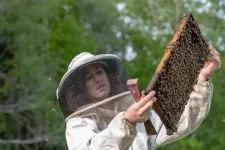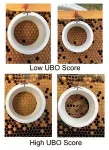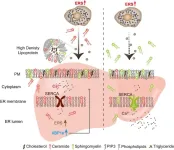“Beekeepers are losing bees at a rate that they say is unsustainable,” says Samantha Alger, director of the Vermont Bee Lab at the UVM and lead author of the study. “In the ‘80s, beekeepers lost colonies 10-12 percent of the time … but now it's like 30-50 percent. Imagine that happening to someone who's a cattle farmer or a pig farmer every year.”
Honey bee populations remain relatively steady despite heavy losses because beekeepers are good at breeding new bees, she explains.
But that comes at the expense of time and resources for beekeepers, as well as risk for native pollinators. Pathogens in managed honey bees can spill over into wild bee populations. Alger’s lab works with beekeepers to breed hardy, disease resistant honey bee colonies which they can sell to hobbyists and professional beekeepers. Helping beekeepers identify hygienic behavior—the ability to identify unhealthy brood— is part of this process.
“It's definitely more desirable for a beekeeper to have bees that are better adapted at taking care of their diseases themselves rather than using chemical treatments and interventions to try to reduce these pathogen loads, which of course may have negative impacts on the bees,” she says. “Now the trick is how does a beekeeper identify a colony that is really hygienic? And there's various tests that you can perform for that and this UBeeO is sort of a novel way of testing for it.”
Alger’s team recently studied a screening tool developed by scientists at the University of North Carolina at Greensboro that tests colonies for hygienic behavior by mimicking the pheromones emitted by sick or dying bees. The researchers found the UBeeO test can identify colonies resistant to several pests and pathogens that can decimate bee populations such as Vairimorpha (known to many beekeepers as Nosema) and fungal infections including chalkbrood. They published their findings in Frontiers in Bee Science April 2.
“UBeeO has been known to identify colonies that are able to better resist Varroa mites, but it had not been used to look at other pest or pathogens,” Alger says. “We found this new assay could be used to identify colonies that are resistant to these other stressors.”
How it works
Picture a honey bee colony. Inside the boxed hive are frames with hexagonal holes where a queen bee lays one egg inside each cell. As the eggs hatch, nurse bees feed the developing larvae and eventually cap over the cells with wax to protect them as they mature into adults. When nurse bees detect a developing bee is sick or dead, they will uncap the cell and remove the pupa to protect the rest of the hive. This is called hygienic behavior and pheromones play an important role in this process.
“Other folks have identified death pheromones, these compounds that are associated with death,” says Kaira Wagoner, a research scientist at UNC Greensboro and co-author of the study. “The famous biologist E.O. Wilson was one of the first to do this. He found oleic acid was emitted from dead ants. The same thing has been found with bees, and it's just likely a stronger signal—it's growing as the dead brood is basically decomposing in the cell. The signals that are coming out of unhealthy brood are different and very likely more subtle than those death pheromones.”
Previous hygiene tests for beekeepers were based off the idea of testing the bees’ ability to detect dead brood. One of the most common methods, the freeze brood assay, involves pouring liquid nitrogen over a section of capped cells and waiting 24 hours to see if the bees start removing the dead. The UBeeO test is different.
“Rather than using liquid nitrogen to kill the developing pupae or larvae, you are using a blend of synthetic pheromones that mimics the same chemicals that are emitted by dying or diseased brood,” Alger explains. “So rather than testing the bees’ ability to identify dead brood, you are testing the bees’ ability to identify diseased brood, which means that this test is a little bit more selective and realistic to what bees experience.”
Wagoner co-developed UBeeO during her doctoral studies after she identified chemical compounds associated with unhealthy brood odors. She co-founded Optera, (named for Hymenoptera, the order of the honeybee), to bring UBeeO to beekeepers in the field. It became publicly available in 2024.
“It's a really young technology,” Wagoner says. “We've now tested it in over 10 different countries, and there are breeding programs in at least 5 now so there's a lot more data to come.”
Strength of the investigation
The study focuses on UBeeO tests performed in three geographic regions—Vermont, North Carolina, and Australia—to examine its effectiveness at recognizing colonies resistant to pathogens and disease. The UBeeO test involves spraying a section of capped cells with synthetic pheromones and then waiting two hours to see if nurse bees have started to inspect the developing bees for problems. The percentage of disturbed cells is the UBeeO score. The researchers found that higher UBeeO scores were associated with lower levels of disease load. The findings also showed various thresholds to disease resistance for common honey bee pathogens.
“What we found, at least with this Australian dataset, is they only needed to achieve a 13 percent response on the UBeeO test to be really pretty resistant to chalkbrood. In contrast, colonies need to achieve a response of 55 or 60% on the UBeeO test to be resistant to mites, Wagoner explains. “The honey bee responsiveness largely depends on how virulent or how harmful the specific disease is to the brood. Chalkbrood kills the brood, so the bees don't have to be as sensitive to detect it.”
Varroa mite infection is trickier. These tiny parasitic mites were introduced about four decades ago in the United States and are vectors of disease to bee populations. They pose a significant threat to colonies and reproduce by laying eggs inside the capped over cells and feed off the developing pupa. If nurse bees don’t detect a problem, Varroa mites will be released into the hive when the young honey bee emerges. That is where hygienic behavior becomes critical since uncapping the cells disrupts the mites’ life cycle.
The study also revealed the UBeeO test could identify colonies with resistance to Vairimorpha (previously Nosema), a disease that affects adult bees and not the developing brood. That finding has prompted new research into how hygienic behavior works to keep these Vairimorpha levels down.
“In the case of Vairimorpha, what they're doing is kind of the mystery,” Alger says. “… There might be other behaviors that hygienic colonies are performing aside of what we know.”
###
Media Contact:
Samantha Alger, Ph.D.
UVM Research Assistant Professor, Agriculture, Landscape, and Environment Department
Phone: 401-862-3322 Email: samantha.alger@uvm.edu
Kaira Wagoner, Ph.D.
UNC Greensboro Research Scientist, Biology Department
Email: KMWAGONE@uncg.edu
END







